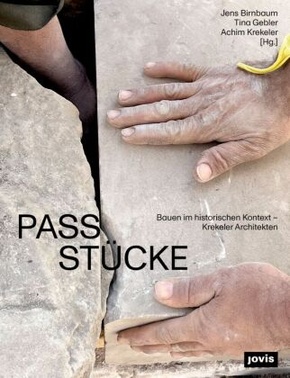PASS-STÜCKE - Bauen im historischen Kontext - Krekeler Architekten
| Verlag | Jovis |
| Auflage | 2024 |
| Seiten | 320 |
| Format | 19,6 x 3,0 x 26,0 cm |
| Gewicht | 1208 g |
| ISBN-10 | 3986121064 |
| ISBN-13 | 9783986121068 |
| Bestell-Nr | 98612106A |
Pass-Stücke stehen für eine Kultur des Bewahrens, der handwerklichen Reparatur und des sensiblen Umbauens von historischer Bausubstanz. Ob Schloss Charlottenburg, Deichtorhallen Hamburg oder Historisches Rathaus Goslar - Krekeler Architekten verstehen jedes Projekt als Unikat mit jeweils eigener Geschichte, Atmosphäre und Ästhetik, eigenen Bedarfen und Möglichkeiten. Das feine Gespür für den Kontext ist der Ausgangspunkt ihrer Entwürfe, um historische Architektur neu zu denken und sensibel weiterzuentwickeln. Das Buch zeigt die Handschrift des international tätigen Architekturbüros anhand von 30 Projekten aus 30 Jahren und lässt dabei die Mitwirkenden selbst zu Wort kommen.
Neue Betrachtungswinkel auf berühmte Denkmäler sowie Neuentdeckungen
30 Best-Practice-Beispiele für Bauen im Bestand, von Brandenburg bis Bukarest
Mit einem Epilog des Architekturkritikers Jürgen Tietz
Pass-Stücke (lit. "fitting pieces") represent a culture of preservation and repair, of skilled craftsmanship, and of the sensitive conversion of historic fabric. Whether it's Schloss Charlottenburg (Charlottenburg Palace) in Berlin, the Deichtorhallen cultural complex in Hamburg, or the historic city hall in Goslar, Krekeler Architekten see every project as a unique space with its own history, atmosphere, and aesthetic-and its own requirements and possibilities. The starting point for their designs is a keen sense of context that allows the reimagining and sensitive reuse of historic architecture. Using thirty projects spanning a period of thirty years and commentary from members of the firm, this volume reveals the internationally active architecture office's unique approach.
Offers a new perspective on both famous monuments and new discoveries
Provides thirty examples of best practice for the reuse of existing buildings-from Brandenburg to B ucharest
Includes an afterword by the architecture critic Jürgen Tietz

